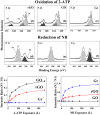Comparative Study of the Catalytic Activities of Three Distinct Carbonaceous Materials through Photocatalytic Oxidation, CO Conversion, Dye Degradation, and Electrochemical Measurements
- PMID: 27762289
- PMCID: PMC5071860
- DOI: 10.1038/srep35500
Comparative Study of the Catalytic Activities of Three Distinct Carbonaceous Materials through Photocatalytic Oxidation, CO Conversion, Dye Degradation, and Electrochemical Measurements
Abstract
In order to compare the catalytic activities of reduced graphene oxide (rGO), graphene oxide (GO), and graphene, we conducted oxidation of 2-aminothiophenol (2-ATP) and reduction of nitrobenzene (NB) in their presence by using high-resolution photoemission spectroscopy (HRPES). In addition, we determined conversion rates of CO to CO2 in the presence of these catalysts by performing a residual gas analyzer (RGA) under a UHV condition, Orange II and methylene blue degradations UV-vis spectrophotometry, and electrochemistry (EC) measurements in an aqueous solution, as well as by obtaining cyclic voltammograms and determining the change of the condition of electrodes before and after the oxidation of 2-ATP. We found that we can successively fabricate GO (oxidation) and graphene (reduction) from rGO by controlling the oxidation or reduction procedure time and then clearly comparing the critical properties among them as we perform various oxidation and reduction activities.
Figures







Similar articles
-
Enhancement of Catalytic Activity of Reduced Graphene Oxide Via Transition Metal Doping Strategy.Nanoscale Res Lett. 2017 Dec;12(1):426. doi: 10.1186/s11671-017-2196-4. Epub 2017 Jun 24. Nanoscale Res Lett. 2017. PMID: 28651385 Free PMC article.
-
Visible light photocatalytic degradation of dyes by bismuth oxide-reduced graphene oxide composites prepared via microwave-assisted method.J Colloid Interface Sci. 2013 Oct 15;408:145-50. doi: 10.1016/j.jcis.2013.07.045. Epub 2013 Jul 27. J Colloid Interface Sci. 2013. PMID: 23953652
-
Determining the Catalytic Activity of Transition Metal-Doped TiO2 Nanoparticles Using Surface Spectroscopic Analysis.Nanoscale Res Lett. 2017 Nov 3;12(1):582. doi: 10.1186/s11671-017-2355-7. Nanoscale Res Lett. 2017. PMID: 29101686 Free PMC article.
-
Graphene-SnO2 composites for highly efficient photocatalytic degradation of methylene blue under sunlight.Nanotechnology. 2012 Sep 7;23(35):355705. doi: 10.1088/0957-4484/23/35/355705. Epub 2012 Aug 15. Nanotechnology. 2012. PMID: 22894878
-
Physical and chemical activation of reduced graphene oxide for enhanced adsorption and catalytic oxidation.Nanoscale. 2014 Jan 21;6(2):766-71. doi: 10.1039/c3nr04282k. Nanoscale. 2014. PMID: 24177433
Cited by
-
Chitosan-Derived Porous Activated Carbon for the Removal of the Chemical Warfare Agent Simulant Dimethyl Methylphosphonate.Nanomaterials (Basel). 2019 Nov 28;9(12):1703. doi: 10.3390/nano9121703. Nanomaterials (Basel). 2019. PMID: 31795246 Free PMC article.
-
Recent Progress on Asymmetric Carbon- and Silica-Based Nanomaterials: From Synthetic Strategies to Their Applications.Nanomicro Lett. 2022 Jan 17;14(1):45. doi: 10.1007/s40820-021-00789-y. Nanomicro Lett. 2022. PMID: 35038075 Free PMC article. Review.
References
-
- Lomeda J. R., Doyle C. D., Kosynkin D. V., Hwang W.-F. & Tour J. M. Diazonium Functionalization of Surfactant-Wrapped Chemically Converted Graphene Sheets. J. Am. Chem. Soc. 130, 16201–16206 (2008). - PubMed
-
- Chen D., Zhang H., Liua Y. & Li, J. Graphene and its derivatives for the development of solar cells, photoelectrochemical, and photocatalytic applications. Energy & Environmental Science 6, 1362–1387 (2013).
-
- Hu P. & Long M. Cobalt-catalyzed sulfate radical-based advanced oxidation: A review on heterogeneous catalysts and applications. Applied Catalysis B: Environmental 181, 103–117 (2016).
-
- Tan Y. B. & Lee J.-M. Graphene for supercapacitor applications. Journal of Materials Chemistry A 1, 14814–14843 (2013).
-
- Dreyer D. R., Jia H.-P. & Bielawski C. W. Graphene Oxide: A Convenient Carbocatalyst for Facilitating Oxidation and Hydration Reactions. Angew. Chem. Int. Ed. 122(38), 6965–6968 (2010). - PubMed
Publication types
LinkOut - more resources
Full Text Sources
Other Literature Sources

